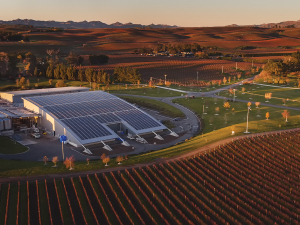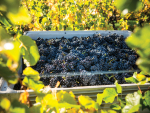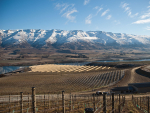Rainfall gauges broke records all over Hawke’s Bay in 2022, including a staggering 4273.5mm for the year at Mt Manuoha.
And that was before Cyclone Gabrielle unleashed her fury on the region in February 2023. Over the course of 10 years in Hawke’s Bay, I have had the privilege of working with many vineyards under some capacity, whether it was as a contractor or part of the winemaking team. Such extreme weather events and their impacts, like the heart-breaking decisions some growers had to make about abandoning their crops, were once a mere prediction; a grim vision of a possible future. Today, they are a stark reality; a manifestation of the escalating issue of climate change.
We need to understand that climate change isn’t an event in the future, it’s happening right now. I feel acutely aware of the challenges and frustrations, but who’s to blame?
Over the past several years, the Intergovernmental Panel on Climate Change (IPCC) has published more than six reports, all of which state that human activities, principally through emissions of greenhouse gases (GHGs), have unequivocally caused global warming. To put that in a language we can all understand, our activities – including producing GHGs – are warming the planet. New Zealand has made commitments to keep global warming below 1.5C, and to do so we need to reduce these emissions fast.
Aotearoa New Zealand, with its Climate Change Commission, the Zero Carbon Act, the release of the first Emission Reduction Plan, Carbon Neutral Government Programme, and sector specific commitments and other programmes, is leading the charge towards a brighter future. The aim is to become climate neutral by 2050 and keep global warming within safe limits. It’s time we acted on this urgent call.
Measure to Manage
The New Zealand wine industry has already stepped up. From the New Zealand Winegrowers (NZW) Annual Report, and my interaction with growers and producers, many of the Sustainable Winegrowing New Zealand (SWNZ) certified wineries have a relative grasp of their carbon emissions. We are also making strides in managing emissions from fuel use (Scope 1 emissions) and exploring alternative technologies that can replace our reliance on fossil fuels. There are some challenges in addressing fuel use, but there is increasing research and development in finding alternates. The low emission technology shown at Fieldays this year was very encouraging to see. I learnt from many in the supply chain that there is ongoing research carried out in developing automated electric options, which may not completely replace a tractor for now, but would substitute in for some tasks like under vine weed management.
Low Hanging Fruit
There are reduction opportunities ripe for the picking. Simply reconsidering our agrichemical inputs, fine tuning application rates, maintaining equipment upkeep in the vineyard, to revisiting our cleaning chemicals, or rethinking water management practices in the winery. All could make a significant difference. But it’s not just about what we do in the vineyards. We can also opt for net carbon zero suppliers to lessen our impact.
Emission reduction options in Scope 2 (purchased energy) have come a long way, even in the last few years that I have been doing GHG accounting and reporting. New Zealand’s electric grid is mostly renewable, and there is an increased number of options available, from moving to net carbon zero suppliers, to the purchase of Renewable Energy Certificates and on-site renewable electricity generation using solar or wind.
Many wineries have switched to ammonia (R717) refrigerants with zero global warming potential. This means a drop in GHG liabilities, which are mandatory to be reported in the GHG inventory when seeking carbon certification. Even minute changes, like preventing accidental leaks from fuel tanks and refrigeration plants, can aggregate into substantial emission reductions over time.
Go Wide for A Bigger Impact
We must not forget about Scope 3 emissions, which arise from our value chain, service providers, and consumers. Under the GHG Protocol, we are encouraged to use supplier specific emissions factors wherever possible. Improving data quality is the first step towards reducing these emissions. After all, we can only manage what we accurately measure. Engaging with your suppliers can also help them make necessary investments and operational decisions to decarbonise.
 |
|---|
|
Uttam Floray
|
Science-based targets are another key piece of the puzzle. The wine industry has committed to the goal of being net carbon zero before 2050. But waiting until the last moment won’t suffice. A steady, ongoing reduction plan can help us track our performance year after year and ensure we stay on course. Science-based targets are key to this, as they help companies set ambitious reduction targets in line with the latest climate science to meet the goals of the Paris Agreement: limiting global warming to well below 2C pre-industrial levels and pursuing efforts to limit warming to 1.5C.
As the climate changes, it has also threatened the terroir, the unique combination of factors including the soil, region, and people that give a wine its character. With shifting climates come new challenges in grape ripeness, disease pressure, and canopy management. Vine diseases are migrating down the latitude, necessitating increased use of agrichemicals in some cases to cope with it. In an interview with The Guardian, John Hancock concurs that the timing of grape harvest in New Zealand has shifted as the climate has changed.
However, adversity breeds innovation. The changing climate has opened opportunities to explore new terroir, experiment with different varietals, and innovate our winemaking styles.
The journey to a greener future is long and challenging, but achievable if we take bold steps, tell compelling stories, and actively encourage every part of our industry to join in the fight against climate change. The future we want to see is within our grasp. Let’s reach out and take it.
Walking the Talk (lightly)
Several New Zealand wine companies are Toitū carbonzero – Yealands, Delegat, Indevin, Lawson’s Dry Hills, Astrolabe and Greystone – as are some of the industry’s biggest suppliers, including Riversun Nursery, Farmlands, and WineWorks. Meanwhile, New Zealand Winegrowers is Toitū carbon reduce certified, and has committed to the goal of the New Zealand wine industry being net carbon zero before 2050.















